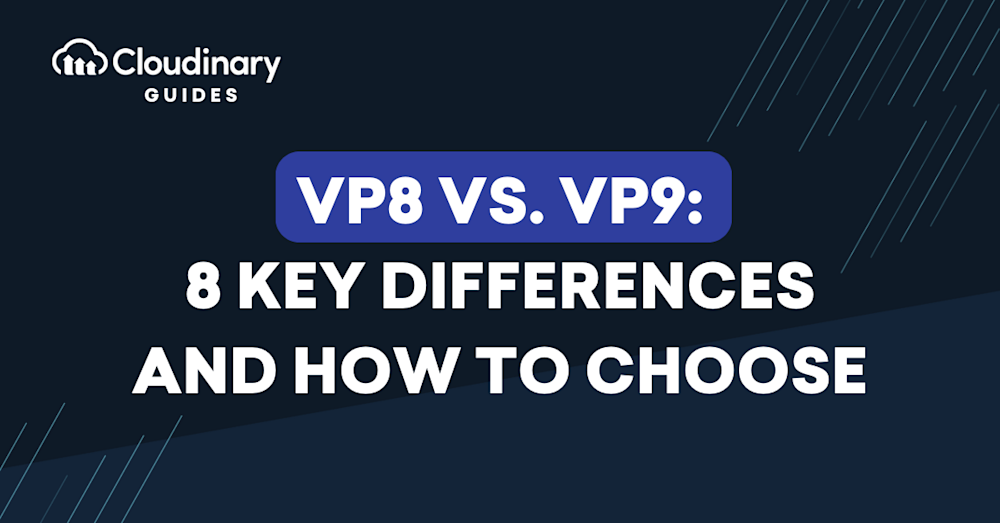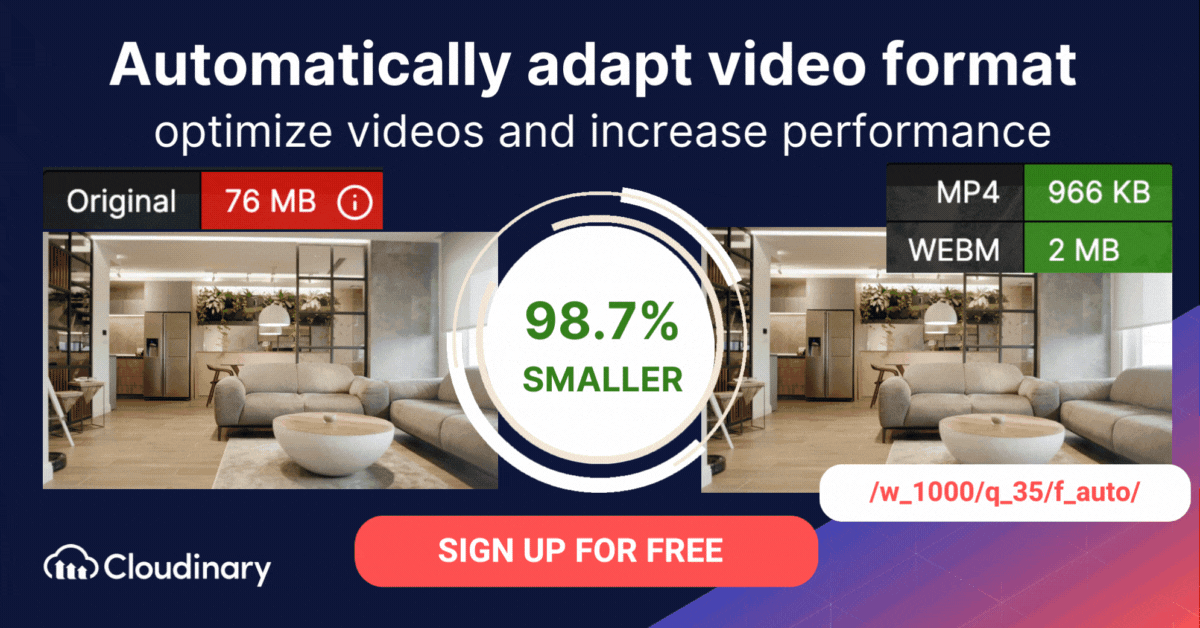
What Is VP8?
VP8 is an open-source, royalty-free video compression format developed by On2 Technologies, later acquired by Google. It is designed to provide high-quality video compression for streaming applications and video conferencing. As the default codec in WebRTC (Web Real-Time Communication), VP8 plays a crucial role in enabling real-time audio and video communication between web browsers and mobile applications without the need for plugins or additional software.
WebRTC users can experience consistent, high-quality video transmission across various platforms and devices, while also benefiting from the open-source and royalty-free nature of the VP8 codec.
What Is VP9?
VP9 is an advanced, open-source, and royalty-free video compression format developed by Google as a successor to VP8. It was created to offer better video quality and compression efficiency, particularly for high-resolution content like 4K and 8K videos. VP9 is the last codec designated as “VP” in the series, as Google transitioned to the more recent AV1 codec afterwards.
Google’s acquisition of On2 Technologies in 2010 played a significant role in the development of both VP8 and VP9 codecs. By acquiring On2, Google gained access to the company’s video compression expertise, which helped them create and promote these codecs as open-source and royalty-free alternatives to other proprietary video compression formats, enabling widespread adoption and improved video streaming experiences.
This is part of a series of articles about video format
In this article:
VP8 vs. VP9: 8 Key Differences
VP8 and VP9 are video coding formats developed by Google, with VP9 being the successor to VP8. Both are part of the WebM project, which aims to provide open, royalty-free multimedia formats for the web. While they share some similarities, there are several key differences between VP8 and VP9 that have led to improvements in video compression efficiency and quality.
1. Compression Efficiency
VP9 offers significantly better compression efficiency compared to VP8. This means that VP9 can deliver similar video quality at lower bitrates, which reduces bandwidth consumption and storage requirements. The improved compression efficiency of VP9 is particularly beneficial for streaming high-resolution video content, such as 4K and 8K, over the internet. On average, VP9 can provide around 30-50% better compression than VP8, depending on the content and settings used.
2. Block Sizes
While both VP8 and VP9 use block-based motion compensation and intra-frame prediction, VP9 supports larger block sizes than VP8. VP8 uses a fixed block size of 16×16 pixels, whereas VP9 supports block sizes ranging from 4×4 to 64×64 pixels. This flexibility allows VP9 to adapt better to different types of video content, resulting in more efficient compression and improved visual quality.
3. Motion Vector Prediction
VP9 introduces more advanced motion vector prediction techniques compared to VP8. In VP9, multiple motion vector candidates can be considered for each block, with the best candidate being selected based on the lowest prediction error. This allows for more accurate motion estimation and compensation, which contributes to the improved compression efficiency of VP9.
4. Tile-based Parallel Processing
VP9 introduces the concept of tile-based parallel processing, which divides the video frame into smaller rectangular regions, or tiles. Each tile can be encoded and decoded independently, allowing for more efficient parallel processing and improved multi-core processor utilization. This feature helps VP9 achieve better real-time encoding and decoding performance on multi-core systems compared to VP8.
5. Rate Control Algorithms
VP9 employs more sophisticated rate control algorithms than VP8. These algorithms help maintain consistent video quality throughout a video stream by dynamically adjusting the quantization parameters and bit allocation based on the complexity of the video content and the target bitrate. The improved rate control algorithms in VP9 contribute to more stable and visually pleasing video quality, especially in scenarios with variable bitrates or network conditions.
6. Scalable Video Coding (SVC)
While both VP8 and VP9 support scalable video coding, VP9 offers more advanced and flexible scalability options. With VP9, it is possible to encode a video stream with multiple spatial, temporal, and quality layers. This allows for adaptive streaming, where the video quality can be dynamically adjusted based on the viewer’s network conditions or device capabilities.
7. High Dynamic Range (HDR) and Wide Color Gamut (WCG) Support
VP9 includes support for High Dynamic Range (HDR) and Wide Color Gamut (WCG) video content. HDR enables a wider range of luminance values, resulting in more realistic and vibrant images, while WCG extends the range of colors that can be represented in a video. VP8 does not natively support HDR or WCG content.
8. Hardware Support
VP9 has gained more widespread hardware support than VP8, with many modern devices, such as smartphones, tablets, and smart TVs, including dedicated VP9 decoding hardware. This hardware support allows for more efficient and power-saving playback of VP9-encoded video on these devices.

VP9 vs H.264
The H.264 codec is designed to compress substantial amounts of video data, allowing it to be streamed online efficiently. It supports HD resolutions of 1280×720 pixels (720p) and 1920×1080 pixels (1080p). For 4K resolution, the total pixel count increases significantly to 3840×2160, requiring enhanced compression methods to manage the data effectively for transmission, storage, and usage. In this regard, VP9 excels by being twice as efficient as H.264, using only half the data to stream 4K content while maintaining high quality.
Pro Tip!
Consider Cloudinary’s Adaptive Bitrate Streaming
Deliver videos instantly without buffering using on-the-fly encoding and automatic format and quality selection.
-> Learn More About Cloudinary’s Video API
VP8 vs. VP9: Which to Choose?
When deciding which codec to use in their video streaming or conferencing software, users should consider the advantages and suitable use cases of each.
VP8 has several advantages as a video codec. Being the default codec in WebRTC, it ensures broad compatibility with various browsers and mobile applications, providing a consistent video streaming experience across different platforms. Its performance is considered equivalent to the widely adopted H.264 codec, while consuming less CPU, making it a suitable choice for devices with limited processing power. These factors contribute to the popularity and widespread use of VP8 for real-time communication on the web.
On the other hand, VP9 offers improved video quality and experience over its predecessor. The most significant advantage of VP9 is its ability to deliver high-quality video at a reduced bitrate, which translates to less data consumption and a more efficient use of network resources. This makes VP9 particularly useful in situations where bandwidth is a constraint. For example, targeting markets with limited bandwidth, such as developing countries, can benefit from the reduced data consumption provided by VP9, allowing users to enjoy better video quality without overloading the network infrastructure.
VP9 is also advantageous for large-scale enterprises with numerous parallel video streams, as it can help optimize network usage and prevent congestion. By utilizing VP9’s enhanced compression efficiency, these organizations can reduce the overall bandwidth required for video conferencing, leading to a more reliable and stable communication experience.


